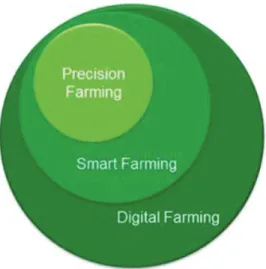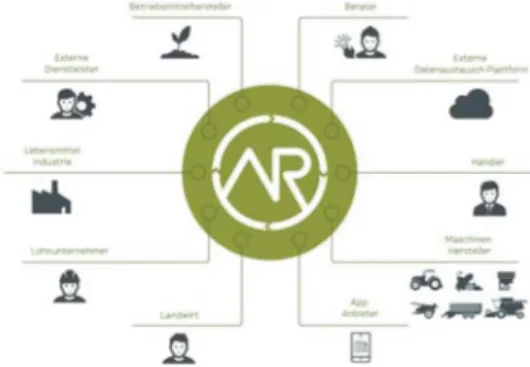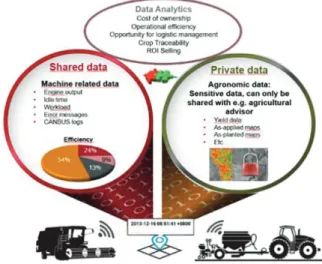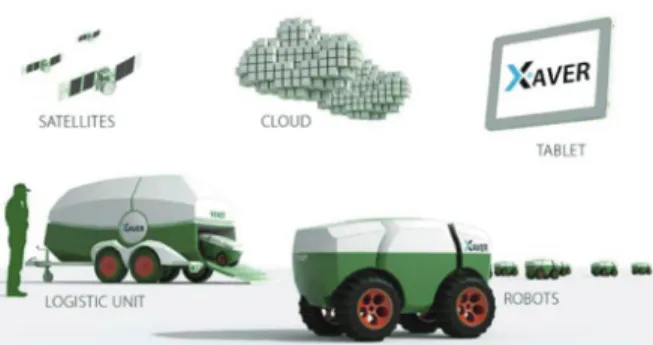Abstract
The Agriculture is faced with the great challenge of feeding more and more people while resources are running out. We are at the beginning of a paradigm shifts in Agribusiness due to digitization. Digital agriculture is seen as a key to mastering this challenge. Digital products on agricultural machinery are not an invention of recent years, but some have more than 30 years of history. The digitally supported Agricultural machines are working on the fields. By deploying sensors and mapping fields, farmers can begin to understand their crops at a micro scale, conserve resources, and reduce impacts on the environment.
Keywords
Precision Farming, Digital Agriculture, AGCO, device compatibility, data compatibility
1. Introduction
It is undisputed, the Agriculture faces major challenges: By 2050, the world's population will rise to 10 billion, but eating habits will also change.
Especially in the so-called emerging economies, there is a trend towards higher-protein food in the form of meat, which in turn causes a greater need for crop production. In addition, there will continue to be a focus on sustainable agriculture. Consumables must therefore be used more consciously and more dosed in order to achieve the maximum effect with these.
These facts are generally recognized by the agricultural engineering industry, but can also be found in the annual reports of almost all companies operating in the agricultural sector. In order to be able
to meet these challenges in the future, digital agriculture has a key role to play. With the widespread use of digitalization, the human-machine relationship is becoming increasingly important, this topic is examined by Szabó et al [1, 2, and 3]. From the agricultural machine perspective, individual solutions such as automatic steering systems became the standard. It should be noted that the more "tangible"
the benefit of a solution is, the adaptation is faster or further advanced on the agricultural machine. The potential for agriculture in the data usage, the big data approach is considered much higher than what has been achieved with on-board technologies so far.
Standardization and compatibility between the different machines and systems on the farm are therefore the key to unlocking this potential. New solutions and services will be developed in order to exploit these potentials together with the farmer.
2. Terminology
Digital agriculture is still a young concept.
Synonymous terms are agriculture 4.0, smart farming or precision farming, whereby the terms are to be considered evolutionary. The latter term has its origins back in the 90s. Griepentrog differentiates between the terms as follows [4]:
–Precision Farming focuses on site-specific processing, in which the growth conditions are optimized by means of sensors and application technology
–Smart Farming adds a level of decision support through fusion and analysis of information.
–Digital Farming (or Agriculture 4.0 or Farming 4.0) includes the Internet of Things as well as Cloud Computing and Big Data.
HUNGARIAN AGRICULTURAL ENGINEERING N° 36/2019 63-68
Published online: http://hae-journals.org/
HU ISSN 0864-7410 (Print) / HU ISSN 2415-9751(Online) DOI: 10.17676/HAE.2019.36.63
DIGITALISATION IN AGRICULTURE – FROM THE PERSPECTIVE OF A GLOBAL AGRICULTURAL MACHINERY PRODUCER
Author(s):
Horváth, János – Schmitz, Bernhard Affiliation:
AGCO Corporation, FUSE EME (https://www.fusesmartfarming.com/) Email address:
Janos.Horvath@agcocorp.com, Bernhard.Schmitz@agcocorp.com
PERIODICAL OF THE COMITTEE OF AGRICULTURAL AND BIOSYSTEM ENGINEERING OF
THE HUNGARIAN ACADEMY OF SCIENCES and
SZENT ISTVÁN UNIVERSITY Faculty of Mechanical Engineering Received: 2019.10. 20. - Accepted: 2019.12. 28.
Figure 1. The development of Precision to Digital Farming
3. AGCO’s history in Digital Farming
AGCO or its predecessor companies, which today belong to the AGCO Group, have a long and successful tradition in precision farming. Just few examples:
–In 1984 Massey Ferguson introduced Datatronic 1, the first on-board computer wherein the processed area and diesel consumption by hour or area could be calculated.
–In 1991, Massey Ferguson launched the yield monitor on MF combines for the first time in the price list commercialized.
–End of the 1990s, then came on the first automatic steering systems on Challenger track type tractors.
–Also in the 1990s, Ag-Chem introduced the area-specific application rate control on self- propelled application machines. Nutrients were first applied based on prescription maps.
–In 1999, an operational telemetry system was first demonstrated on a Massey Ferguson.
In 2013, AGCO bundles its digital farming activities as part of FUSE Technologies. FUSE represents a corporate strategy and the new digital approach of AGCO. Afterwards, the corporate activities are consistently aligned with the new requirements of digital agriculture. Not only technology solutions are development goals of their own, but also Services are made possible based on on-board and off-board technology solutions.
4. Technologies in Use
Although some technologies have been on the market for 30 years or more, their acceptance and distribution is still quite manageable. The biggest breakthrough technology in terms of digital agriculture was the
automatic steering systems offered by all major manufacturers in the early 2000s but also by various aftermarket suppliers. Meanwhile, these systems offer a large potential for savings on equipment but also provide increased area performance and enormous driver relief, are almost standard on large AGCO machines. Today, hardly any AGCO/Fendt 700-1000 series tractors are delivered without automatic steering system. The increasing stability due to the technical progress, better integration into the entire vehicle, cheaper electronic components or GNSS technologies as well as the simply, on-hand advantages of the driver relief were positive influencing factors.
The use of steering systems at AGCO is not limited to large tractors. Meanwhile, e.g. Fendt can offer automatic steering system solution on all tractor series from 70 to 650 hp. The Fendt 200 Vario series is now offering an ultrasound solution for fruit and wine growers. This shows that AGCO seeks the best possible integration of technology solutions into its machines. The step from an automatic steering system to an autonomous vehicle seems quite simple from a technical point of view, but there are legal as well as simply practical reasons against it, since the driver is still needed to monitor the work process, the work quality and possibly to optimize it.
Another technology that is now widely used is the Automatic-Section Control. Individual sections will be switched on or off depending on the position.
There is widespread use in crop protection spraying, fertilizer technology or even single-grain sowing machines, as the increasing working widths make comfortable and precise switching more difficult.
Here, the user can also learn the benefits of SC technology very easily. The average savings potential is about 4.3% based on a Research at Auburn University [5].
The site specific application rate control (VRC, VRT) is considered to have great potential to account for the heterogeneity of a plant population within a plot. The aim is to increase yields and qualities while at the same time adjusting the operating expenses and reducing the environmental impact of these. The area-specific application rate control is still used primarily on large scale farms today, but it is unstoppable spreading in mid-size and smaller farms as well. Since the necessary technical prerequisite already exists on the hardware side due to the automatic steering systems, the step to the partial surface specificity is relatively small. More tractors and implements support this feature, as most modern attachments have software release, thanks to the increasingly widespread ISO 11783 standard called ISOBUS.
Nowadays sensor technology is one of the fastest growing technology area. A sensor is a device capable of detecting a change in the physical or chemical environment which then converts it into electrical signals both electric current and voltage. A number of sensing technologies are used in precision agriculture, providing data that helps farmers monitor and optimize crops, as well as adapt to changing environmental factors including [6]:
–Location Sensors use signals from GPS satellites to determine latitude, longitude, and altitude to within feet.
–Optical Sensors use light to measure soil properties. The sensors measure different frequencies of light reflectance in near-infrared, mid-infrared, and polarized light spectrums. They have for many years offered the possibility of varying the amount of nitrogen during the fertilization process based on the chlorophyll content and the biomass. (Yara N Sensor, Trimble GreenSeeker, Fritzmeier, etc…).
–Electrochemical Sensors provide key information required in precision agriculture: pH and soil nutrient levels.
–Mechanical Sensors measure soil compaction or
“mechanical resistance.”
–Dielectric Soil Moisture Sensors assess moisture levels by measuring the dielectric constant in the soil.
–Airflow Sensors measure soil air permeability.
–Agricultural Weather Stations are self-contained units that are placed at various locations throughout growing fields.
An increasing number of possible data sources as a basis for the sub-area-specific application rate control will significantly increase the importance in the coming years. For example, under the Copernicus program, the EU offers free Sentinel satellite data. In addition, aerial photography using drones is becoming increasingly popular. Both the drones and the sensors have become much cheaper in recent years and will thus be accessible to a wider audience.
The application cards created on the basis of the sensor data can be conveniently and easily exchanged between the machine terminal and a compatible ticket file via mobile-internet in the frame of Order Management Systems like AGCO’s VarioDoc / TaskDoc. This will also promote the acceptance of this technology.
5. Standards and compatibility as the key to success
An important factor for the distribution of automatic section control (SC) or even site specific application
technology (VRC, VRT) is based on the ISOBUS standard, which enables devices from different manufacturers to implement the technology solution in the overall system of tractor and attachment accordingly. As a result, most of the agricultural equipment manufacturers are registered their products in the Agricultural Electronics Industry Foundation.
(https://www.aef-online.org/).
Device compatibility seems to be resolved by adopting and applying the ISO 11783 standard and its chapters.
What about the data compatibility? This topic will be essential to the success of digital agriculture.
AGCO relies consistently on the ISOXML standard.
There is still the big challenge of the interface, because despite the uniform format there are still different interfaces between the different systems between which data is to be exchanged. This interface maintenance is complicated and expensive. A promising, innovative approach is the DKE agrirouter for the European market. The agrirouter provides universal data exchange platform, fills a gap on the way to digital agriculture. Its underlying concept unites cross-vendor and discrimination-free data transfer. Dataflow is shown in the following figure:
Figure 2. The current situation, dataflow without agrirouter
Figure 3. Dataflow with agrirouter
The main stakeholders:
–Farmers, growers, contractors as users can create a free account at https://my-agrirouter.com and set up his own individual ECO system consisting of
machinery and agricultural software solutions from the beginning of 2019.
–Service providers who are technically involved in the context of the agricultural production process and generates, processes or uses data for Agricultural software and telemetry solutions can join to agrirouter community
–Shareholders. The DKE is a consortium of 10 well-known agricultural machinery companies:
AGCO, Amazone, EXEL Industries, Grimme, Horsch, Krone, Kuhn, Lemken, Pöttinger, Rauch, SDF. These companies already have jointly recognized that Farming 4.0 only works if a cross- manufacturer and cross-product data exchange is possible. The consortium is open to further members but only to machine producer companies.
The agrirouter offers a great opportunity to leverage the hidden potential of data stored in a wide range of systems along the value chain. The agrirouter does not save data, it only transfers data. It is guaranteed the privacy.
6. Data privacy and data ownership
The scope and range of available agriculture data is rapidly expanding. This data is being generated, collected, and managed in many forms across agriculture value-chain segments and the potential for this mass of data in its variety, velocity, and volume to impact agriculture is significant. An unprecedented number of choices for integrated systems and solutions have driven the agriculture industry towards the use of data created by computers including but not limited to tractors, combines, environmental sensors, irrigation equipment, grain carts, and unmanned aerial systems. To facilitate the demand for these highly integrated systems and to reap the benefits while reducing risks, it is important to consider how data will be managed. Farm Data has increasing value to farmers. At the same time, farmers are growing more aware of and sensitive to what this data may tell others about their operations. Farmers want transparency regarding the collection, use, sharing options and effective security controls for their data [7].
In the age of broadband internet farmers unintentionally share sensitive information on different platforms. Sometimes it is very risky. The risks also talked about, but not enough and not deep enough. Data protection should be the top priority when using digitally networked farming systems.
Site-specific business and business data may only be used if authorized by the farmer. In US the
Agricultural Data has become one of the most valuable commodities for agricompanies. The sensitive data has become tradable assets of significant commercial value. Farm data would provide immense benefits for agricultural-tech companies and farmers. Companies could use data on fertilizer usage, irrigation and seed type to improve the ways and regions where they market agricultural products, and better tailor their services to the individual needs of farmers. Farmers would benefit from the increased efficiency that data-based insights could provide. With more access to data would come the ability to improve production. There is already considerable interest in data from the agribusiness industry. Monsanto bought Climate Corp, a company using big data for weather services, for almost $1 billion in 2013, the biggest agriculture-technology deal in history.
It is important to highlight that the data belongs to the farmer, can only decide with whom and to what extent to share such data. AGCO has a clear message toward the farmers: the owner of the data who had generated it during the activity on his field. AGCO declares it in EULA Data Sharing section [8]:
“AGCO agrees that you (customer) own any information and data about the machine that is available through the (AGCO’s) Site and Solution.”
AGCO splits the data coming off the machine into two different paths like Machine data to be shared and the sensitive Agronomic data. The data is actually handled very differently between those two different areas of focus.
Figure 4. Data ownership model at AGCO
7. Potential developments for the future
Continuous data collection from soil using Sensor technology. Soil conditions are the most important drivers of biogeochemical processes and biological
activity in the soil, which in turn influence ecosystem properties including plant growth and ecosystem carbon exchange. To better understand these linkages automated sensors can continuously monitor a range of soil properties at terrestrial sites. These sensors can measure physical, chemical and biological properties at the soil surface and in the underground environment. The measurement results can be added to a GIS database facilitates the preparation of prescription maps to create real value of farmers and precision farming service providers.
New Services. Since the farmer cannot generate added value automatically for his business with the increasing amount of data, he will in future be dependent on specialists who translate his data into valuable information. Such value-added services can be differentiated into production-related services and machine-related services. The production-related services will relate to data evaluation on crop production. All available data are prepared for the farmer so that a recommendation for action can be derived from it. The machine-related services link to an optimal support of the machines usage targeting the maximum availability. These wide range of services already offered in the market today, such as machines monitored online via contact-centers, as has already been practiced in the construction machinery sector or transport logistic for several years. The success or failure of new services in digital agriculture based on data collected by sensors or machines will depend less on the willingness of the farmer to share the data than on the reliability and simple understanding of the added value for the farmer.
Autonomous vehicles like XAVER on the field.
Fendt XAVER, formerly known as MARS (Mobile Agricultural Robot Swarm), is a concept where small, swarming robotic units use a cloud solution to plan, monitor and accurately document the precise planting of corn. Key technologies include satellite navigation and data management in the cloud, allowing 24/7 permanent data access. A key element of the XAVER project is the intelligent management of the deployed robots. For example, a Fendt robot system consists of 6–12 units, and can therefore attain an area coverage of around 1 ha/h. Each robot is in constant communication with the control intelligence. Data buffering and redundant communication helps covering breaks in the network coverage. Due to the exact mapping of the deposited sowing unit follow- up work can be carried out highly precisely matched to the individual plant. Thus, the approach has great potential in terms of resource conservation and environmental protection. The low weight of the sowing unit is also extremely gentle to the soil.
Figure 5. Model of AGCO/Fendt XAVER
Setting new interfaces and standards. This is the fundamental basis for serving the data needs of customers with a mix-fleet. Unfortunately we are still far from the ideal world, more efforts and collaboration required.
Conclusion
Although the first digital agriculture solutions were already on the market in the 1990s, the sector has only experienced a veritable boom in the recent years.
Here, the configurations are still such that digital solutions are built on existing machines today and integrated. However, the XAVER approach clearly shows that in the future digital solutions will also influence the overall design of an agricultural machine. New service offerings based on big data will also change the process landscape in agriculture. It can be assumed that these developments are currently still at the beginning.
References
[1] Szabó I., Hushki M., Bártfai Z., Kátai L.:2017.
Operator’s behaviour measuring methodology inside off-road vehicle cabin operator’s focusing scheme In:
Agronomy Research, Volume 15. No. 5. 2017. p.
2172-2182.ISSN1406-894X, https://doi.org/10.15159/AR.17.033
[2] Szabó I., Hushki M., Bártfai Z., Lágymányosi A., Kátai L.:2018. Modelling of operator’s focusing scheme along working hours: Windrowing and cultivating operations. In: Agronomy Research, Volume 16. No. 4. 2018. p. 1885-1895. ISSN 1406- 894X https://doi.org/10.15159/AR.18.155
[3] Szabó I., Hushki M., Bártfai Z., Kátai L.:2019.
Modelling of operator’s focusing scheme along working hours: harvesting operation. In: Agronomy Research, Volume 17. No. 1. 2019. p. 271-280. ISSN 1406-894X, https://doi.org/10.15159/AR.19.026 [4] Griepentrog H.W.:2017. Smart Crop Farming;
Landwirtschaftlicher Hochschultag, Landinfo 3/2017
, pp 13-14
http://www.landwirtschaft-bw.info/pb/site/pbs-bw- new/get/documents/MLR.LEL/PB5Documents/lel/A bteilung_1/Landinfo/Landinfo_extern/2017/03_2017 _HT/Griepentrog_Landinfo3-17.pdf
[5] Winstead A., Fulton J., Mullenix D.: 2010.
Considerations for Adopting & Implementing Precision Ag Technologies; Cornell Precision Agricultural Series.
http://nydairyadmin.cce.cornell.edu/pdf/submission/p df161_pdf.pdf
[6] Schriber S.: 2019. Smart Agriculture Sensors:
Helping Small Farmers and Positively Impacting
Global Issues, Too; Sensor Technology on Mouser Electronics homepage;
https://www.mouser.co.uk/applications/smart- agriculture-sensors/
[7] AgGateway: 2017. Data Privacy and Use White Paper Version 1.2 Updated: March 31, 2017; Scope and Definition of Farm Data Management and Use;
pp 4
[8] AGCO: 2019. FUSE Data Privacy – Telemetry and Task Data EULA;
https://www.fusesmartfarming.com/telemetry-and- task-data-eula/



